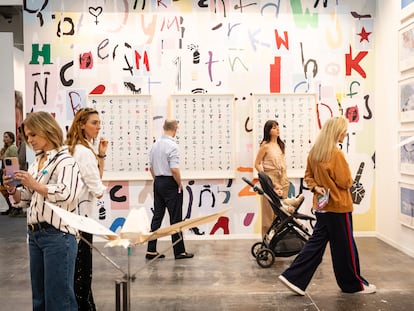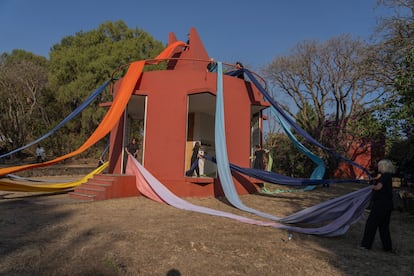The Mexican creator intervenes with ‘Rehilete’ the peculiar architecture of the Casa de Campo of the architect and sculptor Ricardo Regazzoni, in a dialogue between geometry and the fast step of time with a group of 25 volunteers who put a 200 meter cloth in motion

Mexican artist Héctor Zamora (Mexico City, 1974) had an inspiring dream last fall. He stays in the country house of the architect and sculptor Ricardo Regazzoni, located in Tepoztlán, when an October night dreamed that the building of peculiar architecture intervened, built in an irregular, wide and full of fruit trees and jacaranda. Zamora dreamed that a huge white cloth crossed the doors and windows of the house, a small construction in which the madness of geometry blurs the borders of the property and the sensual lines of their concrete walls provide peace, solidity and safety. That epiphany shook Zamora, who was called to get into that house in that house, seize her with her art. After months of planning and work, on Saturday, when the sun exploded with its golden colors in such a beautiful sunset that shuddered the senses, Zamora mounted a crazy performancea dialogue between geometry and the fast passage of time with a group of 25 volunteers who moved a 200 -meter fabric that waved between the doors and windows of the work of Regazzoni. The artist celebrated the life and joy of spring with Receptionhis most recent work.
Reguilete
n “}},”video_agency”:false,”alt_image”:”Reguilete”},”url”:”https://imagenes.elpais.com/resizer/v2/RIC43QO2LJCWRDQMIABUYMAFOQ.jpg?auth=9bcfd8a39c3f710cfa4511fab5e45d8b58e47b04c0c8f9c4d469bd1c0492fb2c&width=1200&height=675&smart=true”,”alt”:”Reguilete”,”ogWidth”:16,”ogHeight”:9});

It is the first time that Zamora presents a performance where the base is the fabric. To do this, he prepared a light blanket painted with colors that recreate the passage of the day, from the bluish black of the night, the orange of the sunsets to the intense yellow of the noon sun. The idea was that the volunteers, all dressed in black, wove the piece by moving the fabric between the housing openings. Zamora began the preparations for his assembly since the early hours of Saturday, when all those involved made several rehearsals so that the work will be perfect at the afternoon. It was the first time since the 1990s that the folding doors of the area occupied by the kitchen of the property, away from the room and the main bedroom opened. It was built on the ground tank, to ensure that it never lacks water in the kitchen. It is a beautiful architecture that reminds a star or a celestial body of the universe, a pavilion crowned with a kind of watchtower, from where you can contemplate the soft landscape of Tepoztlán, that small town south of Mexico City, a area of rocky mountains and extensive forests that is a refuge of the capital that are lucky enough to be able to build there and move away from the chaos of the huge city.
Zamora invited a group of friends, artists and journalists to witness their new work. An excellent quality tequila circulated in the form of fresh cocktails that appeased the heat of spring. Before the initial presentation, the spectators were able to appreciate other works of the artist installed in the broad land of this property of Tepoztlán. Here it was Nseonenosesewhich consists of wind cones located in each of the cardinal points, a piece with which he was a few years ago as the best emerging artist in the prestigious Maco Zone Art Fair, in Mexico City. “Reflect on lies, how we can modify history at will or what we see in politics, which is manipulable,” explains the author. Another of the works is a series of white flags, a fragment of a piece that installed on a beach in New Zealand, composed of 500 of those flags that symbolized the fight of the Maori for their territory. “The white flag was used by the British colonizers to demarcate the space they were taking away from the Maori. Using it is a powerful provocation,” explains Zamora. I was also here Mobulas (2023), seven structures made with ceramic tiles created to intervene urban space. The artist came from presenting last September Emergencya frantic performance in which 600 vases ended trizas in the Madrid gallery Albarrán Bourdais.
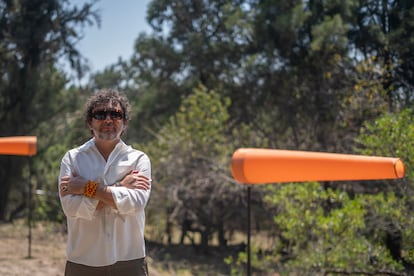
When hot temperatures yielded and the afternoon sun began to give their sensual orange colors, the performance In Tepoztlán. The volunteers dressed in black then wove the huge colored fabric between the windows of the house, in a movement that made it constantly circular it throughout the pavilion. The fabric was interwoven with architecture in a chromatic contrast that highlighted softness and fluidity against the solidity of the structure. “This poetic gesture seeks to caress architecture in an ethereal movement, creating a contemplative and ascetic atmosphere,” explained the organizers. Zamora participated in a moment of the act, playing a huge drum while the sun shone with intense colors in what would be the beginning of the estate of the day. “The night ends!” Shouted the members of the performancewhile they threw from the dark part of the fabric, because each color marked the passage of the day. The powerful movements that penetrate the fabric with sensuality in the structure, the hoarse sound of the drum and the afternoon lights produced an intense, magical and vibrant experience. “It has been an arduous work,” says Arantxa Hernández, one of the volunteers, while sorbe a glass of tequila at the end of the presentation. She was one of the weavers, that is, her function was to guide the fabric to give them to different people to follow the movement cycle. “We practiced several times from dawn and every time it went better. Héctor wanted us to be relaxed, taught us to coordinate and measure our temporality, because sometimes the movement can go very fast, sometimes slower. It was a way of being in team contact,” explains Hernández, a young visual arts student.
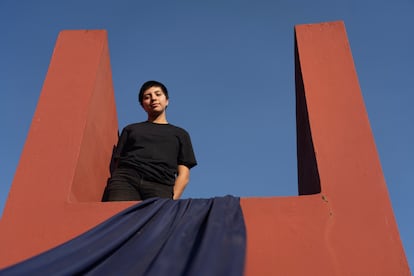
Zamora devised everything as a ritual, which is always important in his work. “That form of work was integrated within my actions, in which I involve a group of people who collaborate with me to do the works, which become a very human process, which generates a very large energy and in that sense a spiritual dimension is generated within the same work,” explains the artist. “I am very interested in this action for everyone’s energy working together at the same time with a specific purpose, which creates a series of reactions that lead us to reflect on the rituals we have as humans and that can be seen very clearly in almost all the cultures of the world,” he adds. The artist did with this ritual in Tepoztlán an applause to life. “This piece becomes a celebration of spring, joy and enjoyment,” he said satisfied with a glass of tequila in his hand.
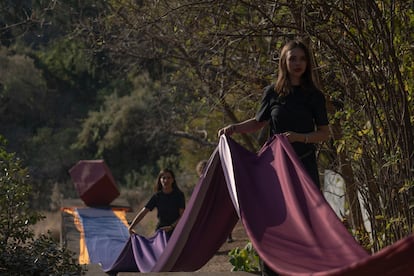
Your subscription is being used on another device
Do you want to add another user to your subscription?
If you continue reading on this device, you cannot read in the other.
Why are you seeing this?
Arrow
Your subscription is being used on another device and you can only access El País from one device at the same time.
If you want to share your account, change your subscription to the premium mode, so you can add another user. Each will access with their own email account, which will allow you to customize your experience in the country.
Do you have a company subscription? Access here to hire more accounts.
In the case of not knowing who is using your account, we recommend changing your password here.
If you decide to continue sharing your account, this message will be shown on your device and in the other person who is using your account indefinitely, affecting your reading experience. You can consult here the terms and conditions of the digital subscription.
About the firm

Editor of the America El País Edition. For eleven years he was in charge of the coverage of Nicaragua, from Managua. Now, in the wording of Mexico City, it covers the news of Central America and education and environmental issues.
More information

